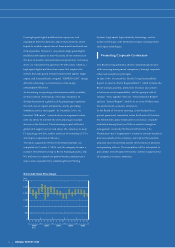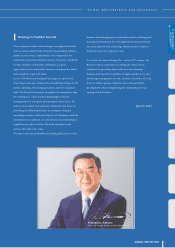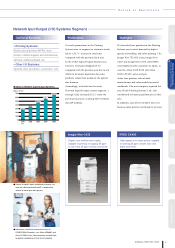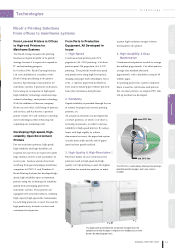Ricoh 2005 Annual Report Download - page 15
Download and view the complete annual report
Please find page 15 of the 2005 Ricoh annual report below. You can navigate through the pages in the report by either clicking on the pages listed below, or by using the keyword search tool below to find specific information within the annual report.
14
ANNUAL REPORT 2005
Environment
* QSU Technology
Quick Start-Up (QSU) technology allows copiers to
quickly recover from standby mode, requiring less
electricity.
* Production Process Innovation
Refer to “Downsized production lines for photosensitive
materials” (p. 35) of the 2005 RICOH GROUP
SUSTAINABILITY REPORT (ENVIRONMENT).
Achieving Both Corporate Growth
and Environmental Goals
To achieve both corporate growth and the
reduction of CO2 emissions, the Ricoh Group
has set the following specific policies:
improving technologies, improving
manufacturing processes, introducing high-
efficiency equipment and natural energy
systems. Among these policies, Ricoh places
priority on improving technologies and
manufacturing processes because they have the
most impact on reduction of CO2 emissions
and corporate growth. Ricoh considers it
absolutely necessary to pursue profits while
changing over to more environmentally-
friendly technologies in order to compete
internationally.
In 1999, Ricoh developed an innovative
technology for copiers called QSU*. The
reduction of CO2 emissions while using digital
multifunction copiers equipped with this
technology is estimated at about 15,000
tons/year. As far as the reduction of CO2
emissions from business activities is concerned,
there is not much more to be done, as various
activities are already being carried out. In order
to reduce CO2 emissions further, it is
necessary to change the manufacturing
process. In 2004, with an innovative
production process for photo conductors,
Ricoh was successful in making the process
line more compact, and was able to reduce
CO2 emissions for each photo conductor by
69%. By combining this new production
process with other low-key efforts to reduce
CO2 emissions, Ricoh is closer to achieving
our goal of 12% and is preparing to take the
next step in this effort.
Economy with Emphasis on
Environmental Friendliness
The Ricoh Group considers reforming the
structure of corporate management, to be the
key to environmental management. Promoting
this reform can be expensive and place high
demands on employees. However, Ricoh has
placed new corporate value on environmental
management, and is determined to promote
reform while defying the trend to maintain the
status quo.
Since the establishment of our Environment
Promotion Office in 1976, Ricoh has been
creating the right climate and gaining human
resources for environmental management, and
is now viewed as a leader in this area. As the
world shifts toward an economy emphasizing
environmental friendliness, and as the speed of
change accelerates with the Kyoto Protocol
going into effect, Ricoh will continue to
promote our core values.
To Our Shareholders
and Customers
Review of Operations
(General Information by Business Area)
Technology Corporate Social
Responsibility Environment Financial Section
























